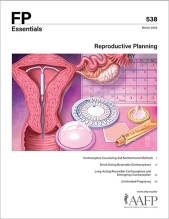
This clinical content conforms to AAFP criteria for CME.
Short-acting reversible contraceptives (SARCs) are prescribed routinely by primary care clinicians. SARCs are among the most commonly prescribed contraceptive methods and include combined hormonal oral contraceptive pills, the combined hormonal transdermal patch, the combined hormonal vaginal ring, progestin-only pills, and the 3-month depot medroxyprogesterone acetate injection. To ensure safe prescribing and reduce barriers to receiving SARC methods, family physicians should be familiar with two evidence-based national contraceptive guidelines, the U.S. Medical Eligibility Criteria for Contraceptive Use (U.S. MEC) and the U.S. Selected Practice Recommendations for Contraceptive Use (U.S. SPR). SARCs have benefits in addition to pregnancy prevention; as such, these methods may be chosen for reasons other than contraception.
Case 2. BT is a 35-year-old patient with controlled hypertension who smokes 1pack/day of cigarettes. She recently had a copper intrauterine device removed after 10 years because of intermittent cramping and heavy menstrual periods while it was in place. At her wellness examination, she tells you she did well when taking birth control pills in her early 20s and would prefer to go back to them.
Short-acting reversible contraceptives (SARCs) are among the most commonly used contraceptive methods in the United States27 and include combined hormonal contraceptives, which contain estrogen and a progestin; progestin-only pills; and depot medroxyprogesterone acetate (DMPA) injections. Combined hormonal contraceptives come in the form of oral pills, transdermal patches, and vaginal rings. The progestin in combined hormonal contraceptives works by preventing pregnancy, whereas the estrogen stabilizes the endometrial lining and controls menstrual bleeding.42
Subscribe
From $350- Immediate, unlimited access to FP Essentials content
- 60 CME credits/year
- AAFP app access
- Print delivery available
Edition Access
$44- Immediate, unlimited access to this edition's content
- 5 CME credits
- AAFP app access
- Print delivery available
